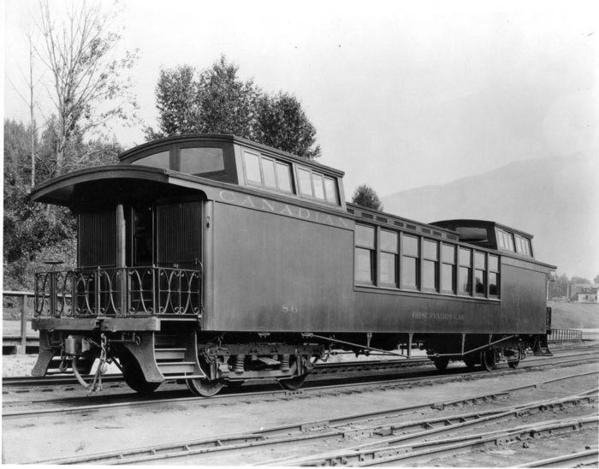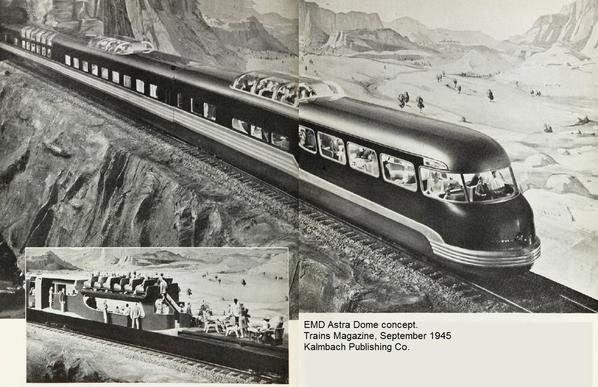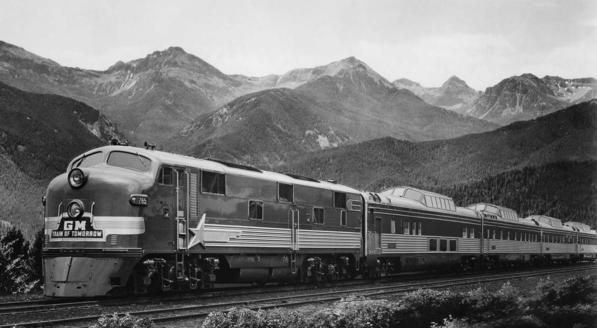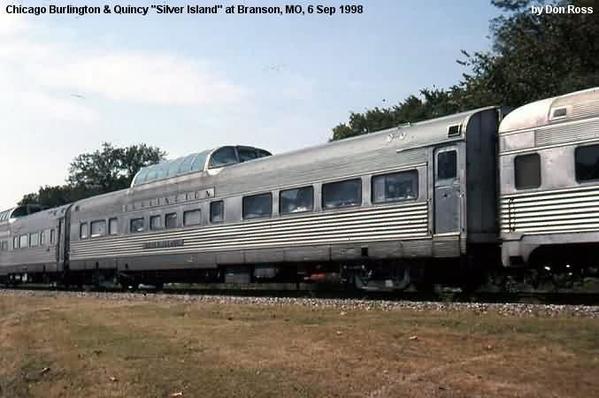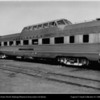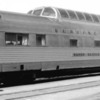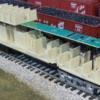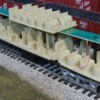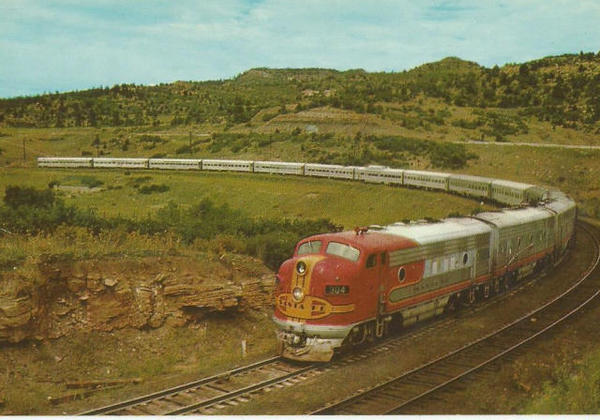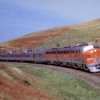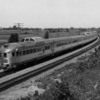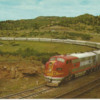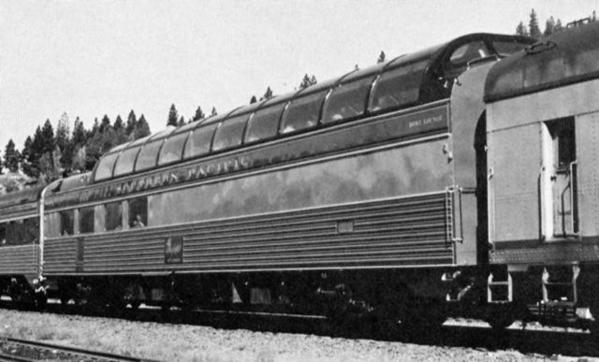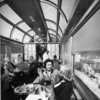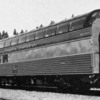Since their introduction in 2001, the American Models Budd passenger cars have graced the rails of many an S railroad. Fine cars, but the selection has been lacking several body styles. One such car was the vista-dome. No more. Huzzah.
But first, a very brief and incomplete history of the dome car:
I suppose it can be said the Chicago, Burlington and Quincy railroad pioneered the dome car back in the 1891. I’ve found references to a so-called “birdcage car” but haven’t been able to locate an illustration of the car. A suggestion has been made that it may have been an inspection car and not a revenue car. So, an unsolved mystery exists.
Moving up to 1902, the Canadian Pacific built an “observation” car, consisting of a coach with essentially two cupolas, each located on the end of the car. A photograph exists of this car:
Three more similar cars were constructed in 1906, the main difference is these also had glass panels on the roof. In those pre-air conditioning days, it must have gotten quite toasty in the observation “domes” on a warm sunny day
The inspiration for the modern dome car came from Cyrus Osborn of EMD while riding in a D&RGW F-unit through Glenwood Canyon. Noting the wonderful view of the scenery from the cab, Mr. Osborn thought passengers should be afforded such a view.
In 1944, railroad executives met in a former automobile showroom in Oak Park, Illinois. These executives were presented with concepts by GM and EMD for an Astra-Dome passenger car. While GM and EMD had no intention of getting in to the passenger car business, (rather more as a way to sell more locomotives) the concepts were made available to all.
However, General Motor’s Harley Earl directed a team working with Pullman Standard that would result in GM’s barnstorming “Train of Tomorrow” of 1947.
Meanwhile CB&Q’s president, Ralph Budd took the ideas and worked with the Budd Company (no relationship) and built the first vista-dome as we know it in 1945.
The CB&Q flat roof coach “Silver Alchemy” was brought into the road’s Aurora Shops and modified with a dome. This car became the so-called ‘pattern dome’ and the car was renamed “Silver Dome.” Deemed a success, the flat roof coach “Silver Castle” was also so modified, but did not receive a new name.
These two domes differed from Budd production domes in the dome glass was flat due to the unavailability of curved glass at the time. Curved glass became available in time for the first production domes for the Burlington, resulting in a much more elegant appearance. The Burlington ordered the first five production Budd domes to re-equip the Chicago-Minneapolis Twin Zephyrs of which the Silver Island was one.
Which brings us to the American Models new Budd dome. The AM dome appears to be patterned after the Budd-built Burlington dome coach cars. The cars are not full scale length, but 72’ scale feet long (not counting diaphragms and couplers,) and are designed to complement the previous AM Budd cars. The car body appears to be compressed in length rather than by eliminating a window to shorten the car. The dome weighs in at 1 pound 3 ounces, the same as the earlier Budd cars.
My domes are the silver painted scale versions lettered for the Burlington. The scale version comes with truck mounted, Kadee compatible “Snap-Lock”couplers.
Overall, AM has captured the essence of the Burlington Budd dome coach very well. Prototype dome cars have several variations with respect to the side windows, depending on the interior configuration. The AM dome appears to be patterned after the CB&Q “Silver Buckle,” originally built for re-equipping the Denver Zephyr. The window count and placement is correct for the Silver Buckle, so the car is compressed in length rather than have a window eliminated. (Oddly, Silver Buckle isn’t one of the names AM used…)
So, what we have here is a dome car released 15 years after the introduction of the AM Budd cars. The silver paint matches perfectly with my cars purchased in 2001. The domes share the underfame and trucks of the earlier Budd coaches. The dome cars roll well, but a drop of oil on the axel ends won’t hurt. A pair of AM E8’s (no Gription™ Traction on scale wheeled units) will easily handle all 10 cars on my allegedly level track. That’s almost 12 pounds of S Scale rolling thunder, folks.
I had one problem, however. One coupler on one dome was mounted upside-down and the axle blocks the mounting screw. However, it’s an easy process to pop out the wheelset, unscrew the coupler, flip it over and put it all back together again. No sweat.
I mentioned in an earlier post I had some concerns based on the photos. One is disappointing, but not a show stopper and the other wound up being minimal.
The disappointment is that the letter board and number/name board is centered on the car body and not under the dome. While this was the location on the Burlington’s Silver Dome and Silver Castel dome conversions, this isn’t the way it was on production Budd domes. I’ve been convincing my inner nit-picker that this isn’t a tragedy. It does seem more noticeable on the solid silver cars vs. the painted or striped cars.
The other was the dome itself. I was worried that the dome might be too narrow. It was difficult to tell in earlier side view photos.
Such is not the case, the dome width appears to match photos of prototype domes, with the appropriate “bump-out” of the roofline under the dome. At first glance, it appeared that the dome might be a little too far forwards, but this appears to be an illusion created by the position of the letter boards. My initial concern about the overall appearance of the dome was based on the old, 1985 era AM dome which never looked quite right to me.
I will say the dome itself appears to have rather hefty window frames when compared to the prototypes and make it look a little top heavy. The fact the window insert doesn’t sit flush with the dome frame doesn’t help. It also appears slightly flatter than it should be. The “rivets” (which appear oversized) represent the bolts that hold the window trim and gaskets in place. However, overall the appearance of the dome portion is good.
The dome itself is three pieces. The dome proper is molded with the car body. The ends of the dome are separate parts that snap into the roof.
As with the earlier Budd cars, the AM domes have an interior of tan colored plastic and a PC board for lighting. Four screws hold the frame to the body. Once removed, the frame slides out easily so one could detail, paint or populate the interior if so desired.
Unlike the earlier Budd cars, the new domes use LEDs for lighting. There are surface-mount LEDs to illuminate the main level while two LEDs rise like cobras through the floor to illuminate the dome.
Here’s how the dome’s LEDs compare with the incandescent light in a coach at 12 volts:
The LED’s in the dome itself appear to have a slight greenish tinge to them, at least to my eyes.
American Models is offering the dome in all previous roadnames, except Illinois Central (poor sales.) I’m a bit puzzled as to why there’s no chromed New Haven listed, but chromed Union Pacific is listed.
So, after this long-winded essay, I give American Models an A- on the dome cars mainly because of the letter board and number/name board locations. No harm, no foul in offering them as a 72’ car to match their existing Budd cars. These cars are a fine addition to their passenger fleet.
I’ll conclude with an image of the domes ‘rounding the curve at Cherryvale on the Kansas Grain Belt.
Rusty




